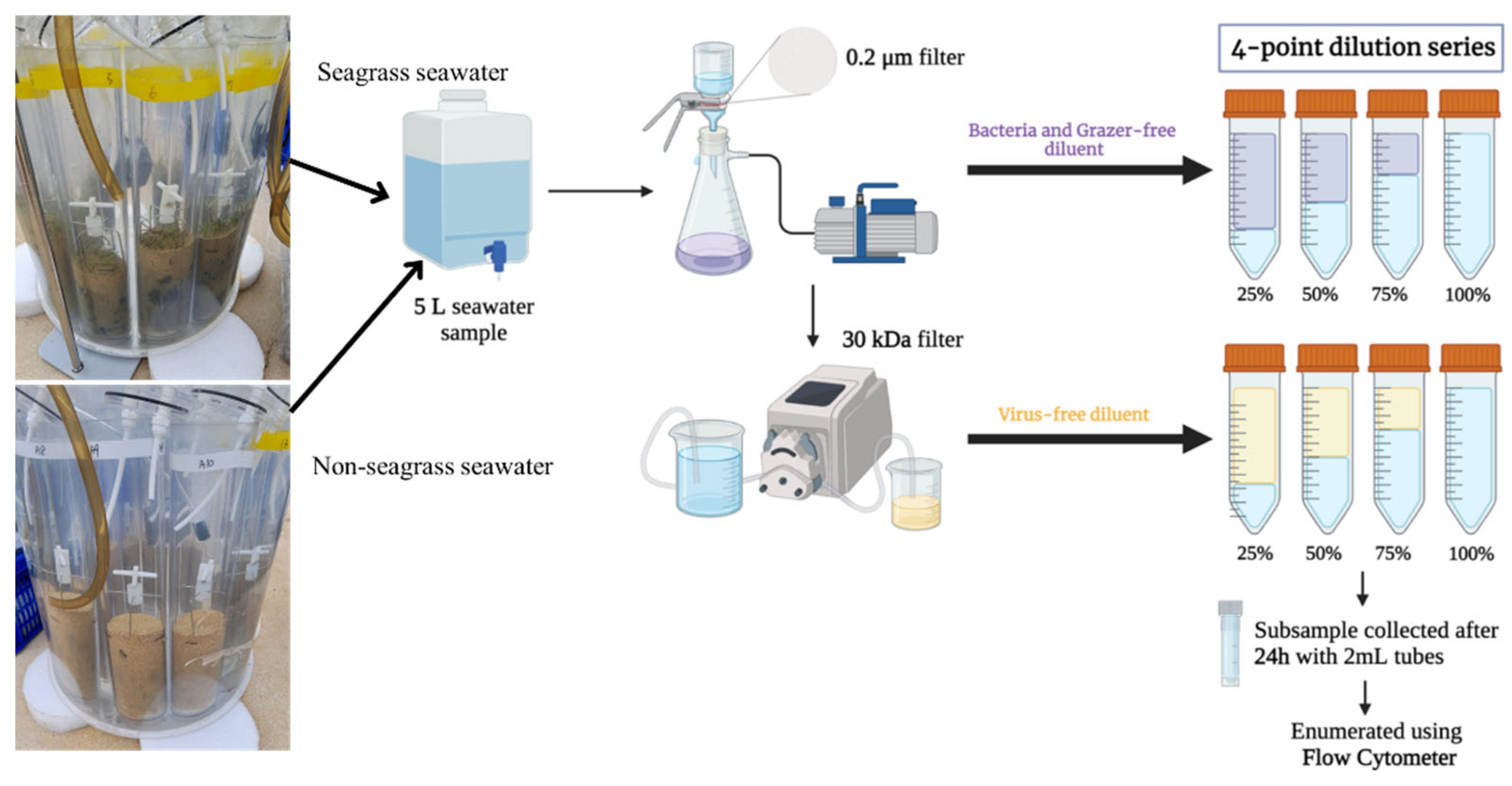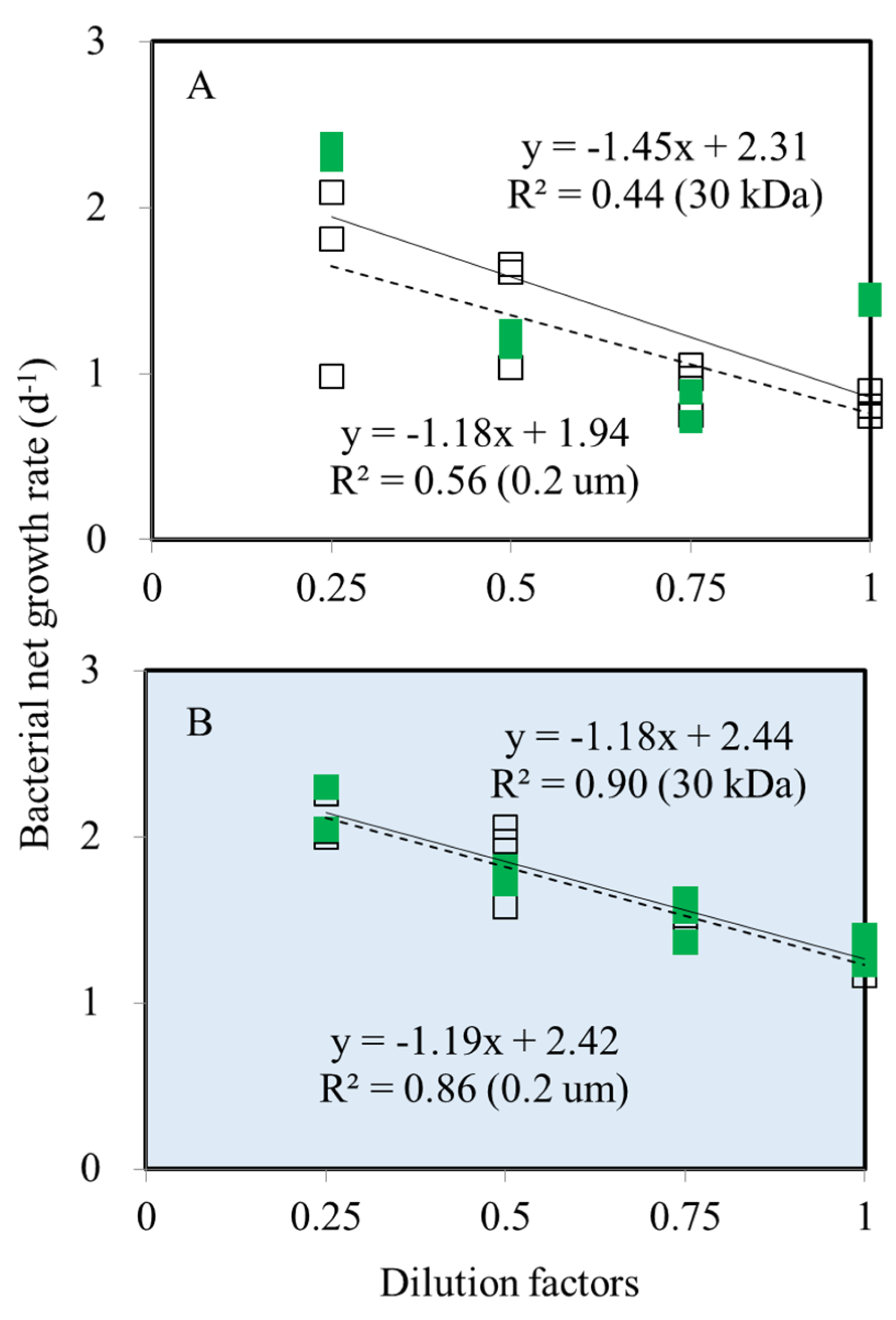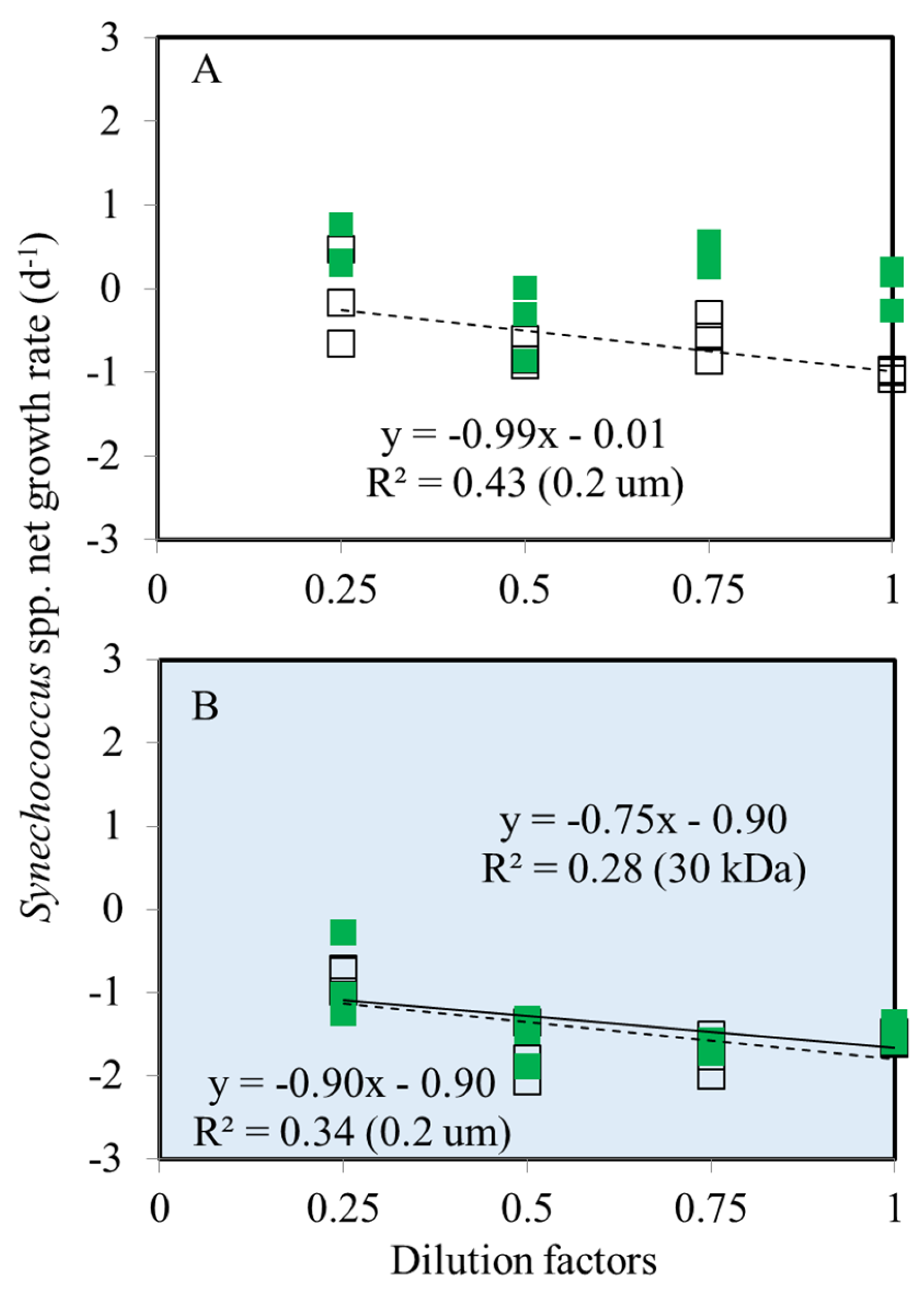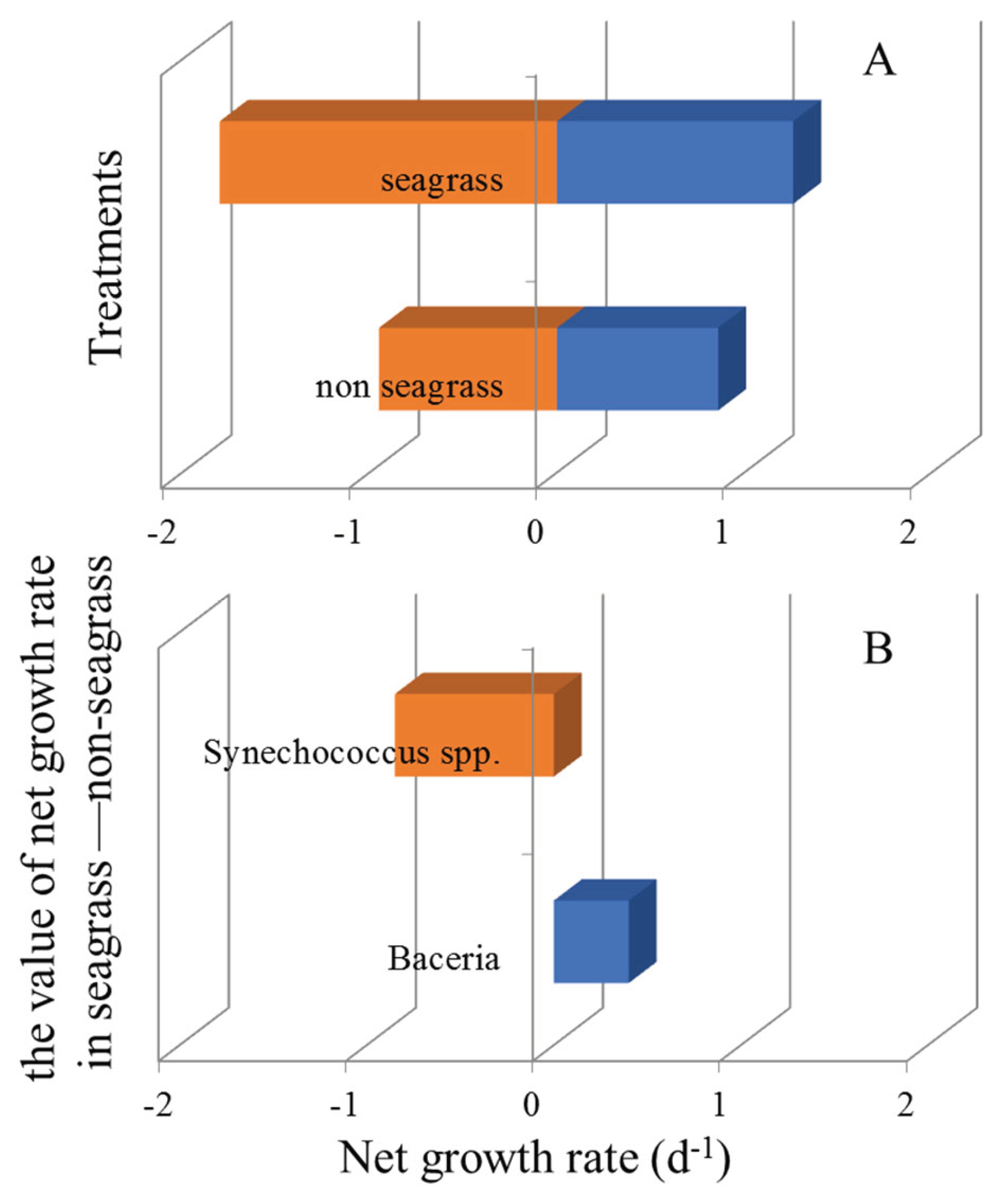Submitted:
18 February 2024
Posted:
19 February 2024
You are already at the latest version
Abstract
Keywords:
1. Introduction
2. Materials and Methods
2.1. Study Site and Sampling Methods
2.2. Modified Dilution Experiments
2.3. Flow Cytometric Analysis
2.4. Data Analysis.
3. Results
3.1. Bacterial and Synechococcus spp. Growth Rates
3.2. Bacterial and Synechococcus spp. Mortality
4. Discussion
Author Contributions
Funding
Acknowledgments
Conflicts of Interest
References
- Connolly, R.M.; Hindell, J.S. Review of nekton patterns and ecological processes in seagrass landscapes. Estuar Coast Shelf Sci. 2006, 68, 433–444. [Google Scholar] [CrossRef]
- Horinouchi, M. Review of the effects of within-patch scale structural complexity on seagrass fishes. J Exp Mar Biol Ecol. 2007, 350, 111–129. [Google Scholar] [CrossRef]
- Hendriks, I.E.; Sintes, T.; Bouma, T.J.; Duarte, C.M. Experimental assessment and modeling evaluation of the effects of the seagrass Posidonia oceanica on flow and particle trapping. Mar Ecol Prog Ser. 2008, 356, 163–173. [Google Scholar] [CrossRef]
- Unsworth, R.K.F.; Nordlund, L.M.; Cullen-Unsworth, L.C. Seagrass meadows support global fisheries production. Conserv Lett. 2019, 12, e12566. [Google Scholar] [CrossRef]
- Pollard, P.C.; Moriarty, D.J.W. Organic carbon decomposition, primary and bacterial productivity, and sulphate reduction, in tropical seagrass beds of the Gulf of Carpentaria, Australia. Mar Ecol Prog Ser. 1991, 69, 149–159. [Google Scholar] [CrossRef]
- Lindeboom, H.J.; Sandee, A.J.J. ; Production and consumption of tropical seagrass fields in eastern Indonesia measured with bell jars and microelectrodes. Neth J Sea Res. 1989, 23, 181–190. [Google Scholar] [CrossRef]
- Mateo, M.A.; Romero, J. Detritus dynamics in the seagrass Posidonia oceanica: elements for an ecosystem carbon and nutrient budget. Mar Ecol Prog Ser. 1997, 151, 43–53. [Google Scholar] [CrossRef]
- Barrón, C.; Apostolaki, E.T.; Duarte, C.M. Dissolved organic carbon fluxes by seagrass meadows and macroalgal beds. Front Mar Sci. 2014, 1, 42. [Google Scholar]
- Martin, B.C.; et al. Low light availability alters root exudation and reduces putative beneficial microorganisms in seagrass roots. Front Microbiol. 2018, 8, 2667. [Google Scholar] [CrossRef]
- Lønborg, C.; Álvarez-Salgado, X.A.; Duggan, S.; Carreira, C. Organic matter bioavailability in tropical coastal waters: the Great Barrier Reef. Limnol Oceanogr. 2018, 63, 1015–1035. [Google Scholar] [CrossRef]
- Furnas, M.; Mitchell, A.; Skuza, M.; Brodie, J. In the other 90%: phytoplankton responses to enhanced nutrient availability in the Great Barrier Reef Lagoon. Mar Pollut Bull. 2005, 51, 253–265. [Google Scholar] [CrossRef] [PubMed]
- Buitenhuis, E.; Li, W.; Vaulot, D.; Lomas, M.; Landry, M.; Partensky, F. , et al. Picophytoplankton biomass distribution in the global ocean. Earth Syst Sci Data. 2012, 4, 37–46. [Google Scholar] [CrossRef]
- Kristensen, E.; Bouillon, S.; Dittmar, T.; Marchand, C. Organic carbon dynamics in mangrove ecosystems: a review. Aquat Bot. 2008, 89, 201–219. [Google Scholar] [CrossRef]
- Apple, J.K.; Giorgio, P.D. Organic substrate quality as the link between bacterioplankton carbon demand and growth efficiency in a temperate salt-marsh estuary. ISME J. 2007, 1, 729–742. [Google Scholar] [CrossRef] [PubMed]
- Delille, D.; Canon, C.; Windeshausen, F. Comparison of Planktonic and Benthic Bacterial Communities Associated with a Mediterranean Posidonia Seagrass System. Botanica Marina. 1996, 39, 234–249. [Google Scholar] [CrossRef]
- Jones, W.B.; Cifuentes, L.A.; Kaldy, J.E. Stable Carbon Isotope Evidence for Coupling between Sedimentary Bacteria and Seagrasses in a Sub-Tropical Lagoon. Mar Ecol Prog Ser. 2003, 255, 15–25. [Google Scholar] [CrossRef]
- Säwström, C.; Hyndes, G.A.; Eyre, B.D.; Huggett, M.J.; Fraser, M.W.; Lavery, P. S. , et al. Coastal connectivity and spatial subsidy from a microbial perspective. Ecol Evol. 2016, 6, 6662–6671. [Google Scholar] [CrossRef]
- Tsai, A.Y.; Gong, G.C.; Hung, J. Seasonal variations of virus- and nanoflagellate-mediated mortality of heterotrophic bacteria in the coastal ecosystem of subtropical western Pacific. Biogeosciences. 2013, 10, 3055–3065. [Google Scholar] [CrossRef]
- Morán, X.A.; Baltar, G.; Carreira, F.C.; Lønborg, C. Responses of physiological groups of tropical heterotrophic bacteria to temperature and DOM additions: food matters more than warming. Environ Microbiol. 2020, 22, 1930–1943. [Google Scholar] [CrossRef]
- Vaqué, D.; Alonso-Sáez, L.; Arístegui, J.; Agustí, S.; Duarte, C.M.; Montserrat Sala, M. , et al. Bacterial production and losses to predators along an open ocean productivity gradient in the Subtropical North East Atlantic Ocean. J Plankton Res. 2014, 36, 198–213. [Google Scholar] [CrossRef]
- Chen, P.W.-Y.; Olivia, M.; Chou, W.-C.; Shiu, R.-F.; Mukhanov, V.; Tsai, A.-Y. Differences in Bacterial Growth and Mortality between Seagrass Meadows and Adjacent Unvegetated Areas. J Mar Sci Eng. 2023, 11, 1979. [Google Scholar] [CrossRef]
- Llabrés, M.M.; Agustí, S. Picophytoplankton cell death induced by UV radiation: evidence for oceanic Atlantic communities. Limnol Oceanogr. 2006, 51, 21–29. [Google Scholar] [CrossRef]
- Yang, D.; Shan, X.; Liu, S. Bacterioplankton, Picoeukaryotes and Synechococcus Distribution Associated with Seagrass in South Coast of Hainan Island, China. Natu Resour. 2014, 2014. [Google Scholar] [CrossRef]
- Wit, R.; Troussellier, M.; Courties, C.; Buffan-Dubau, E.; Lemaire, E. Short-Term Interactions between Phytoplankton and Intertidal Seagrass Vegetation in a Coastal Lagoon (Bassin d’Arcachon, SW France). Hydrobiol. 2012, 699, 55–68. [Google Scholar] [CrossRef]
- Agawin, N.S.; Duarte, C.M. Evidence of direct particle trapping by a tropical seagrass meadow. Estuaries. 2002, 25, 1205–1209. [Google Scholar] [CrossRef]
- Evans, C.; Archer, S. D.; Jacquet, S.; Wilson, W.H. Direct estimates of the contribution of viral lysis and microzooplankton grazing to the decline of a Micromonas spp. population. Aquat Microb Ecol. 2003, 30, 207–219. [Google Scholar] [CrossRef]
- Hammes, F.; Egli, T. Cytometric methods for measuring bacteria in water: Advantages, pitfalls and applications. Anal Bioanal Chem. 2010, 397, 1083–1095. [Google Scholar] [CrossRef]
- Olson, R.J.; Zettler, E.R.; Armbrust, E.V.; Chisholm, S.W. Pigment, size and distribution of Synechococcus in the North Atlantic and Pacific oceans. Limnol Oceanogr. 1990, 35, 45–58. [Google Scholar] [CrossRef]
- Landry, M.R.; Hassett, R.P. Estimating the grazing impact of marine microzooplankton. Mar Biol. 1982, 67, 283–288. [Google Scholar] [CrossRef]
- Weinbauer, M.G.; Christaki, U.; Nedoma, A.; Simek, K. Comparing the effects of resource enrichment and grazing on viral production in a meso-eutrophic reservoir. Aquat Microb Ecol. 2003, 31, 137–14. [Google Scholar] [CrossRef]
- Kimmance, S.A.; Brussaard, C.P.D. Estimation of viralinduced phytoplankton mortality using the modified dilution method. In: Wilhelm S, Weinbauer M, Suttle C (eds) Manual of aquatic viral ecology. American Society of Limnology and Oceanography, Waco, TX, 2010, 65–73.
- Traving, S.J.; Clokie, M.R.J.; Middelboe, M. Increased acidification has a profound effect on the interactions between the cyanobacterium Synechococcus sp. WH7803 and its viruses. FEMS Microbiol Ecol. 2014, 87, 133e141. [Google Scholar] [CrossRef] [PubMed]
- Miki, T.; Jacquet, S. Complex interactions in the microbial world: underexplored key links between viruses, bacteria and protozoan grazers in aquatic environments. Aquat Microb Ecol. 2008, 51, 195–208. [Google Scholar] [CrossRef]
- Bettarel, Y.; Sime-Ngando, T.; Bouvy, M.; Arfi, R.; Amblard, C. Low consumption of virus-sized particles by heterotrophic nanoflagellates in two lakes the French Massif Central. Aquat Microb Ecol. 2005, 39, 205–209. [Google Scholar] [CrossRef]
- Holmer, M.; Andersen, F.Ø.; Nielsen, S.L.; et al. The importance of mineralization based on sulphate reduction for nutrient regeneration in tropical seagrass sediments. Aquat Bot. 2001, 71, 1–17. [Google Scholar] [CrossRef]
- Williams, C.J.; Boyer, J.N.; Jochem, F.J. Microbial activity and carbon, nitrogen, and phosphorus content in a subtropical seagrass estuary (Florida Bay): evidence for limited bacterial use of seagrass production. Mar boil. 2009, 156, 341–353. [Google Scholar] [CrossRef]
- Deborde, J.; Abril, G.; Mouret, A.; Jézéquel, D.; Thouzeau, G.; Clavier, J.; et al. Effects of seasonal dynamics in a Zostera noltii meadow on phosphorus and iron cycles in a tidal mudflat (Arcachon Bay, France). Mar Ecol Prog Ser. 2008, 355, 59–71. [Google Scholar] [CrossRef]
- Hansen, J.W.; Udy, J.W.; Perry, C.J.; Dennison, W.C.; Lomstein, B.A. Effect of the seagrass Zostera capricorni on sediment microbial processes. Mar Ecol Prog Ser. 2000, 199, 183–196. [Google Scholar] [CrossRef]
- Eyre, B.D.; Ferguson, A.J. Comparison of carbon production and decomposition, benthic nutrient fluxes and denitrification in seagrass, phytoplankton, benthic microalgae-and macroalgae-dominated warm-temperate Australian lagoons. Mar Ecol Prog Ser. 2002, 229, 43–59. [Google Scholar] [CrossRef]
- Rizzo, W.M.; Lackey, G.J.; Christian, R.R. Significance of eutrophic, subtidal sediments to oxygen and nutrient cycling in a temperate estuary. Mar Ecol Prog Ser. 1992, 86, 51–61. [Google Scholar] [CrossRef]
- Cummins, S.P.; Roberts, D.E.; Ajani, P.; Underwood, A.J. Comparisons of assemblages of phytoplankton between open water and seagrass habitats in a shallow coastal lagoon. Mar freshw Res. 2004, 55, 447–456. [Google Scholar] [CrossRef]




Disclaimer/Publisher’s Note: The statements, opinions and data contained in all publications are solely those of the individual author(s) and contributor(s) and not of MDPI and/or the editor(s). MDPI and/or the editor(s) disclaim responsibility for any injury to people or property resulting from any ideas, methods, instructions or products referred to in the content. |
© 2024 by the authors. Licensee MDPI, Basel, Switzerland. This article is an open access article distributed under the terms and conditions of the Creative Commons Attribution (CC BY) license (http://creativecommons.org/licenses/by/4.0/).




